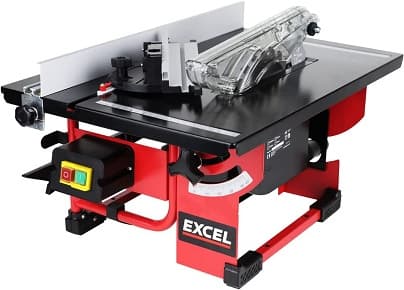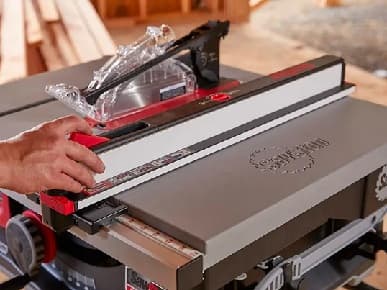As an Amazon Associate, I earn from qualifying purchases.

Table saws are an important part of any woodworking shop. They are used to make straight and accurate cuts in boards. In this tutorial, we will show you how to use a table saw safely and effectively.
Contents
Understanding The Table Saw
A table saw consists of a circular saw blade mounted on an arbor, protruding through the top of a flat table surface. The blade can be adjusted in height and angled to make different types of cuts. The table provides support for the workpiece, and the fence acts as a guide to ensure straight and accurate cuts.
Safety Precautions
Before using a table saw, it’s crucial to prioritize safety. Here are some essential safety precautions to follow:
- Always wear safety goggles, ear protection, and a dust mask.
- Keep the workspace clean and organized to prevent accidents.
- Ensure the blade guard, anti-kickback pawls, and riving knife are properly installed.
- Use a push stick or push block to keep your hands away from the blade.
- Avoid loose-fitting clothes and jewelry that can get caught in the saw.
- Disconnect the power and wait for the blade to stop spinning before making any adjustments.
- Never reach over the saw blade while it’s running or remove the waste material until the blade stops.
Choosing The Right Table Saw

When selecting a table saw, consider the following factors:
- Types of table saws: There are three common types—portable, contractor, and cabinet table saws. Choose one that suits your needs and workspace.
- Power and motor size: Higher horsepower allows for smoother cuts and better performance.
- Fence quality: A reliable fence system ensures accuracy and ease of use.
- Safety features: Look for a saw with essential safety features, such as blade guards and anti-kickback devices.
- Budget: Determine your budget and find a table saw that offers the best value for your money.
Setting Up The Table Saw
Before using the table saw, you need to set it up correctly:
- Find a suitable location with enough space for the saw and workpiece.
- Ensure the table saw is placed on a stable and level surface.
- Adjust the height of the blade to the desired position.
- Install the blade guard, splitter, and anti-kickback pawls.
- Align the fence parallel to the blade.
Adjusting The Blade And Fence
To achieve accurate cuts, it’s crucial to adjust the blade and fence properly:
Adjusting the blade:
- Use the height adjustment mechanism to set the blade at the desired height for the cut you intend to make. Lower the blade below the table surface when not in use.
- Ensure the blade is parallel to the miter slots or the fence to prevent binding and inaccurate cuts.
- Check the blade alignment by using a square or a specialized blade alignment tool. Make adjustments if necessary.
Adjusting the fence:
- Align the fence parallel to the blade by loosening the locking mechanism and sliding it into the desired position.
- Use a measuring tape or a precision fence gauge to ensure the fence is parallel along its entire length.
- Tighten the locking mechanism securely to hold the fence in place during cutting.
Basic Table Saw Techniques
Once your table saw is set up correctly, you can start using it to make various cuts. Here are some basic techniques:
Ripping
Ripping refers to cutting wood along its length. Follow these steps to rip a piece of wood:
- Measure and mark the desired width of the rip cut on the workpiece.
- Adjust the fence to the correct distance from the blade, ensuring it is parallel to the blade and securely locked.
- Stand to the side of the workpiece, keeping your hands clear of the blade path.
- Turn on the saw, push the workpiece against the fence, and feed it steadily through the blade, maintaining firm control throughout the cut.
- Use a push stick or push block for narrower pieces to maintain a safe distance from the blade.
Crosscutting
Crosscutting involves cutting wood across its width. Follow these steps to make a crosscut:
- Measure and mark the desired length of the crosscut on the workpiece.
- Use a miter gauge or a crosscut sled to guide the workpiece across the blade.
- Ensure the miter gauge or sled is securely locked in the miter slot and aligned with the cut line.
- Hold the workpiece firmly against the miter gauge or sled, keeping your hands clear of the blade.
- Switch on the saw and push the workpiece across the blade, maintaining control and a steady forward motion.
Bevel Cuts
Bevel cuts involve tilting the blade to an angle other than 90 degrees. Follow these steps to make bevel cuts:
- Adjust the bevel angle on the saw according to the desired tilt.
- Measure and mark the angle and length of the cut on the workpiece.
- Adjust the fence and miter gauge/sled as necessary for accurate positioning.
- Hold the workpiece firmly against the fence or miter gauge/sled, ensuring your hands are away from the blade path.
- Turn on the saw and slowly feed the workpiece through the blade, maintaining control throughout the cut.
Dado Cuts
Dado cuts involve removing a groove or channel from the wood. Follow these steps to make dado cuts:
- Install a dado blade set appropriate for the width of the groove you want to cut.
- Adjust the height of the dado blade to the desired depth.
- Measure and mark the width and location of the dado cut on the workpiece.
- Set the fence and miter gauge/sled to position the workpiece accurately.
- Hold the workpiece securely against the fence or miter gauge/sled, keeping your hands clear of the blade.
- Turn on the saw and slowly feed the workpiece through the blade, ensuring a steady and controlled movement.
Miter Cuts
Miter cuts involve cutting wood at an angle other than 90 degrees. Follow these steps to make miter cuts:
- Adjust the miter gauge or bevel the blade to the desired angle.
- Measure and mark the angle and length of the cut on the workpiece.
- Align the workpiece against the miter gauge or use a miter sled for precise cuts.
- Hold the workpiece securely against the miter gauge or sled, away from the blade path.
- Switch on the saw and slowly feed the workpiece through the blade, maintaining control and a smooth motion.
Using Jigs And Accessories
Jigs and accessories can enhance the capabilities and safety of your table saw. Here are some commonly used ones:
- Push sticks and push blocks: These help keep your hands at a safe distance from the blade while providing a firm grip on the workpiece.
- Featherboards: Featherboards hold the workpiece against the fence or table, ensuring consistent pressure and preventing kickback.
- Crosscut sleds: A crosscut sled provides a larger and more stable platform for crosscutting wide or long workpieces accurately.
- Dado sleds: Similar to crosscut sleds, dado sleds hold the workpiece securely when making dado cuts, ensuring precise results.
- Miter sleds and gauges: These accessories assist in making accurate miter cuts at various angles.
Maintaining And Cleaning The Table Saw

Proper maintenance and regular cleaning are essential for the longevity and optimal performance of your table saw. Follow these maintenance tips:
- Keep the table surface clean and free of debris to prevent interference with the workpiece.
- Check and tighten any loose bolts, screws, or belts.
- Lubricate the moving parts according to the manufacturer’s instructions to ensure smooth operation.
- Clean the blade and remove any built-up residue with a blade cleaner or appropriate solvent.
- Inspect the blade for damage or dullness and replace it if necessary.
- Store the table saw in a dry and secure location when not in use to protect it from dust and potential damage.
Troubleshooting Common Issues
Even with proper usage and maintenance, table saws can encounter some issues. Here are common problems and their potential solutions:
- Blade not cutting straight: Check the alignment of the blade, fence, and miter gauge/sled. Adjust and tighten as necessary.
- Burning or scorching of wood: Ensure the blade is sharp and clean. Adjust the feed rate and avoid feeding the workpiece too slowly.
- Excessive noise or vibration: Check for loose components and tighten them. Inspect the blade for damage or warping.
- Difficulty adjusting the blade height or bevel angle: Clean the elevation or bevel adjustment mechanisms and apply lubrication. If the problem persists, consult the manufacturer’s instructions or seek professional assistance.
Frequently Asked Questions (FAQs)
Can I use a table saw to cut materials other than wood?
Yes, depending on the type of table saw and the appropriate blade, you can cut materials such as plywood, MDF, plastic, and even some metals.
Is it necessary to wear safety goggles when using a table saw?
Absolutely. Safety goggles protect your eyes from flying debris and potential accidents. Always wear them when operating a table saw.
What should I do if the wood gets stuck or binds during a cut?
Stop immediately and do not force the wood. Turn off the table saw, wait for the blade to stop spinning, and carefully remove the wood. Check for any irregularities or adjustments needed before continuing.
How often should I replace the table saw blade?
The frequency of blade replacement depends on usage and the type of material being cut. As a general guideline, it’s recommended to replace the blade when it becomes dull, damaged, or shows signs of excessive wear.
Can I perform table saw maintenance myself?
Yes, you can perform basic maintenance tasks such as cleaning, lubricating, and tightening loose components. However, for more complex repairs or adjustments, it’s advisable to consult the manufacturer’s instructions or seek professional assistance.
What safety precautions should I take when changing the blade?
Always disconnect the power source before changing the blade. Use appropriate tools, such as a blade wrench, to remove and install the blade. Follow the manufacturer’s instructions carefully and ensure the blade is securely tightened.
Conclusion
A table saw is a powerful woodworking tool that can be dangerous if not used correctly. In this article, we have covered the basics of how to use a table saw safely and effectively. We recommend reading this article carefully before using a table saw for the first time.



